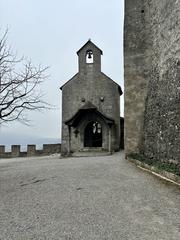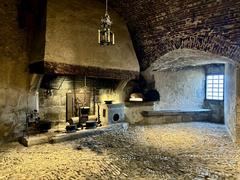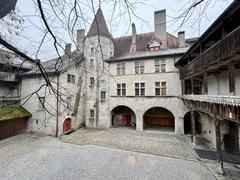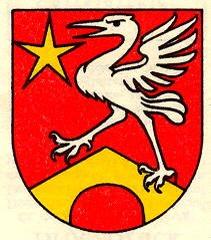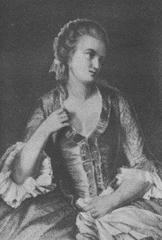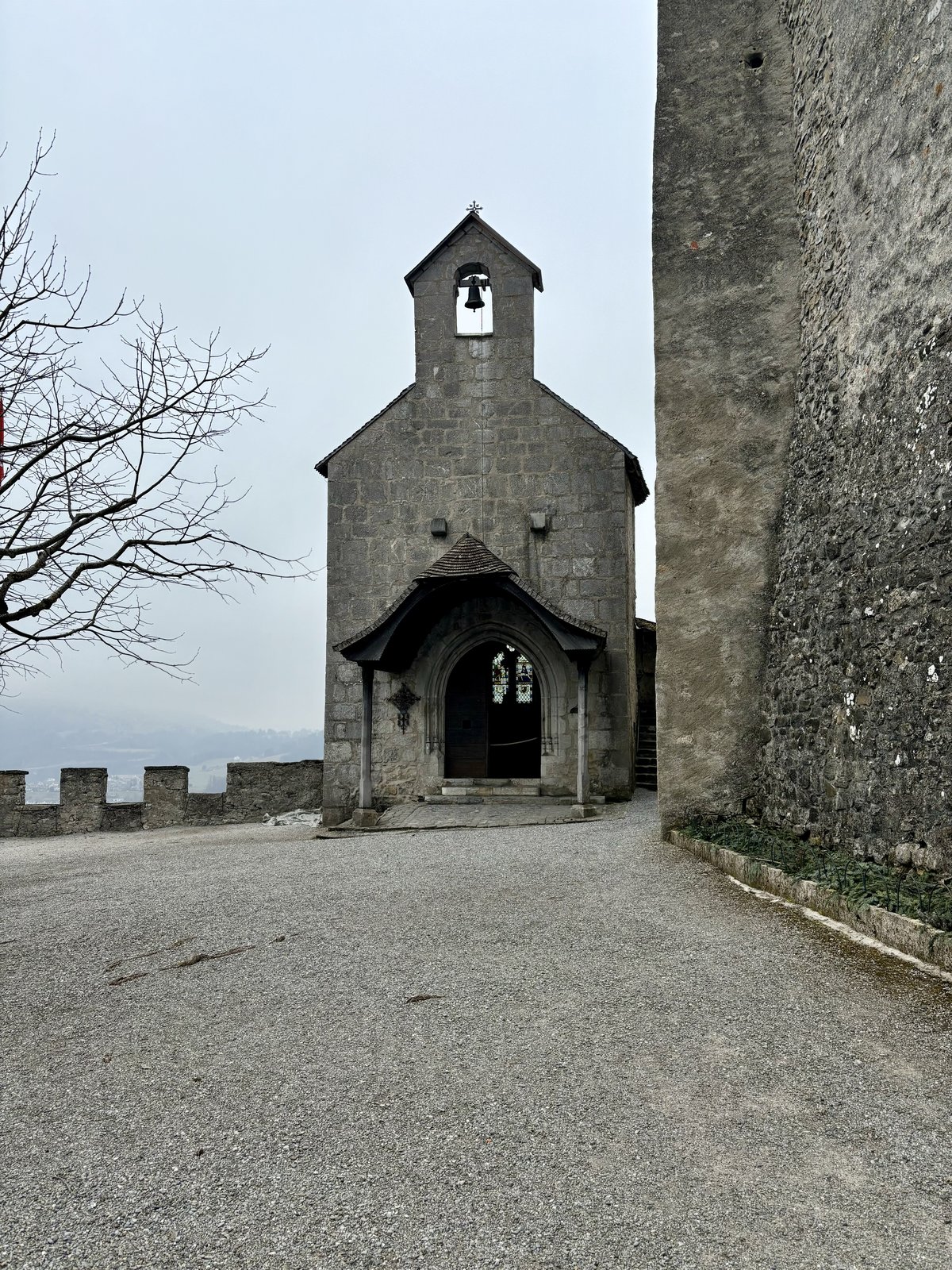
Guide to Visiting Château de Gruyères in Pringy, Switzerland
Date: 17/07/2024
Introduction
Nestled in the heart of the picturesque town of Pringy in the canton of Fribourg, Switzerland, the Château de Gruyères is a stunning testament to medieval architecture and rich history. This 13th-century castle, built by Count Pierre II of Gruyères, offers visitors a unique journey through time with its well-preserved rooms, historical artifacts, and captivating architecture (Gruyères Castle website). Whether you’re a history enthusiast, an architecture buff, or simply seeking a captivating day trip, the Château de Gruyères promises an unforgettable experience. This guide provides an in-depth look into its historical significance, architectural marvels, cultural contributions, and practical visitor information, ensuring you make the most of your visit to this iconic Swiss landmark.
Table of Contents
- Introduction
- Early Beginnings and Construction
- The Gruyères Counts
- Financial Decline and Sale
- Transformation and Renovation
- 19th Century and Artistic Influence
- Acquisition by the Bovy and Balland Families
- 20th Century and Museum Establishment
- Modern-Day Significance
- Visitor Information
- Conclusion
- FAQ
Early Beginnings and Construction
The Château de Gruyères, built around 1270 by Count Pierre II of Gruyères, is located in the town of Gruyères in the canton of Fribourg, Switzerland. The strategic location on a hilltop provided a defensive advantage, overseeing the Saane Valley and controlling trade routes between the regions of Vaud and Fribourg.
The Gruyères Counts
The Gruyères family, who gave their name to the region and the famous cheese, resided in the castle for several centuries. Known for their military prowess and political acumen, the counts of Gruyères were influential figures in the region. The castle served not only as a residence but also as a symbol of their power and influence until the mid-16th century when financial difficulties led to its sale.
Financial Decline and Sale
In 1554, Count Michel of Gruyères faced insurmountable debts, leading to the family’s bankruptcy. The castle and its surrounding lands were subsequently divided between the cantons of Fribourg and Bern. The canton of Fribourg took control of the castle, transforming it into the residence of the bailiff, the representative of the canton.
Transformation and Renovation
During the 17th and 18th centuries, the Château de Gruyères underwent several renovations and transformations. The medieval fortress was gradually transformed into a more comfortable residence, reflecting the changing needs and tastes of its occupants. Notable additions during this period include the construction of new living quarters and the enhancement of the castle’s defensive features.
19th Century and Artistic Influence
In the 19th century, the Château de Gruyères experienced a revival of interest, particularly from artists and writers. The famous French painter Jean-Baptiste Camille Corot’s paintings of the castle and its surroundings helped to popularize the site, drawing attention to its cultural and historical value.
Acquisition by the Bovy and Balland Families
In 1849, the castle was purchased by the Bovy and Balland families, who were instrumental in preserving and restoring the historic structure. The Bovy family, notably Daniel Bovy, a noted artist, and his wife, Marie, dedicated themselves to the restoration and preservation of the castle, ensuring it remained a well-preserved example of medieval architecture.
20th Century and Museum Establishment
In 1938, the Château de Gruyères was acquired by the canton of Fribourg, which undertook extensive restoration work to preserve the castle’s historical features. The castle was transformed into a museum, showcasing its rich history and cultural heritage. Today, it is open to the public, offering visitors a glimpse into the past through its well-preserved rooms, historical artifacts, and stunning architecture.
Modern-Day Significance
The Château de Gruyères remains a significant cultural and historical landmark in Switzerland. It is a popular tourist destination, attracting visitors from around the world who come to explore its rich history and enjoy its picturesque setting. The castle hosts various cultural events, exhibitions, and festivals throughout the year, further enhancing its status as a center of cultural and historical significance.
Visitor Information
Opening Hours
The castle is open every day from 9:00 AM to 6:00 PM (April to October) and from 10:00 AM to 5:00 PM (November to March).
Ticket Prices
Adult tickets are CHF 12, children (6-16 years) are CHF 4, and children under 6 enter for free. Discounts are available for groups and families.
Guided Tours
Guided tours are available in multiple languages, offering deeper insights into the castle’s history and architecture.
Special Events
The castle hosts various events throughout the year, including medieval festivals, art exhibitions, and concerts.
Nearby Attractions
Don’t miss the Gruyères Cheese Factory, the HR Giger Museum, and the breathtaking hiking trails around the region.
Accessibility
The castle is partially accessible to visitors with limited mobility. Specific areas may have restricted access due to the historical nature of the site.
Conclusion
The Château de Gruyères is not just a historical monument but a vibrant cultural hub that continues to enchant visitors from around the globe. Its rich history, stunning architecture, and scenic location make it a must-visit destination in Switzerland. Whether you’re exploring the medieval rooms, attending a cultural event, or simply enjoying the panoramic views, the Château de Gruyères promises an experience that is both educational and inspiring.
Frequently Asked Questions (FAQ)
Q: What are the visiting hours for Château de Gruyères? A: The castle is open every day from 9:00 AM to 6:00 PM (April to October) and from 10:00 AM to 5:00 PM (November to March).
Q: How much do tickets cost? A: Adult tickets are CHF 12, children (6-16 years) are CHF 4, and children under 6 enter for free. Discounts are available for groups and families.
Q: Are guided tours available? A: Yes, guided tours are available in multiple languages, offering deeper insights into the castle’s history and architecture.
Q: What nearby attractions should I visit? A: Nearby attractions include the Gruyères Cheese Factory, the HR Giger Museum, and the breathtaking hiking trails around the region.
Q: Is the castle accessible for visitors with limited mobility? A: The castle is partially accessible to visitors with limited mobility. Specific areas may have restricted access due to the historical nature of the site.
